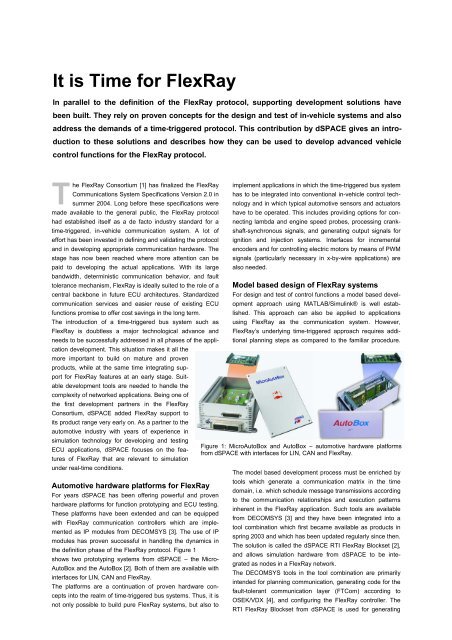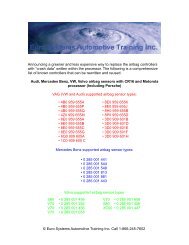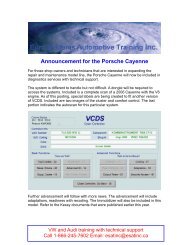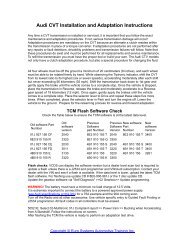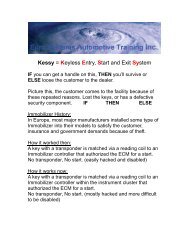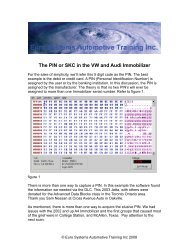It is Time for FlexRay - Euro Systems Automotive Training Inc.
It is Time for FlexRay - Euro Systems Automotive Training Inc.
It is Time for FlexRay - Euro Systems Automotive Training Inc.
Create successful ePaper yourself
Turn your PDF publications into a flip-book with our unique Google optimized e-Paper software.
<strong>It</strong> <strong>is</strong> <strong>Time</strong> <strong>for</strong> <strong>FlexRay</strong><br />
In parallel to the definition of the <strong>FlexRay</strong> protocol, supporting development solutions have<br />
been built. They rely on proven concepts <strong>for</strong> the design and test of in-vehicle systems and also<br />
address the demands of a time-triggered protocol. Th<strong>is</strong> contribution by dSPACE gives an introduction<br />
to these solutions and describes how they can be used to develop advanced vehicle<br />
control functions <strong>for</strong> the <strong>FlexRay</strong> protocol.<br />
T<br />
he <strong>FlexRay</strong> Consortium [1] has finalized the <strong>FlexRay</strong><br />
Communications System Specifications Version 2.0 in<br />
summer 2004. Long be<strong>for</strong>e these specifications were<br />
implement applications in which the time-triggered bus system<br />
has to be integrated into conventional in-vehicle control technology<br />
and in which typical automotive sensors and actuators<br />
made available to the general public, the <strong>FlexRay</strong> protocol have to be operated. Th<strong>is</strong> includes providing options <strong>for</strong> con-<br />
had establ<strong>is</strong>hed itself as a de facto industry standard <strong>for</strong> a necting lambda and engine speed probes, processing crank-<br />
time-triggered, in-vehicle communication system. A lot of shaft-synchronous signals, and generating output signals <strong>for</strong><br />
ef<strong>for</strong>t has been invested in defining and validating the protocol ignition and injection systems. Interfaces <strong>for</strong> incremental<br />
and in developing appropriate communication hardware. The encoders and <strong>for</strong> controlling electric motors by means of PWM<br />
stage has now been reached where more attention can be signals (particularly necessary in x-by-wire applications) are<br />
paid to developing the actual applications. With its large<br />
bandwidth, determin<strong>is</strong>tic communication behavior, and fault<br />
also needed.<br />
tolerance mechan<strong>is</strong>m, <strong>FlexRay</strong> <strong>is</strong> ideally suited to the role of a Model based design of <strong>FlexRay</strong> systems<br />
central backbone in future ECU architectures. Standardized For design and test of control functions a model based devel-<br />
communication services and easier reuse of ex<strong>is</strong>ting ECU opment approach using MATLAB/Simulink® <strong>is</strong> well estab-<br />
functions prom<strong>is</strong>e to offer cost savings in the long term.<br />
l<strong>is</strong>hed. Th<strong>is</strong> approach can also be applied to applications<br />
The introduction of a time-triggered bus system such as using <strong>FlexRay</strong> as the communication system. However,<br />
<strong>FlexRay</strong> <strong>is</strong> doubtless a major technological advance and <strong>FlexRay</strong>’s underlying time-triggered approach requires addi-<br />
needs to be successfully addressed in all phases of the application<br />
development. Th<strong>is</strong> situation makes it all the<br />
more important to build on mature and proven<br />
products, while at the same time integrating support<br />
<strong>for</strong> <strong>FlexRay</strong> features at an early stage. Suitable<br />
development tools are needed to handle the<br />
complexity of networked applications. Being one of<br />
the first development partners in the <strong>FlexRay</strong><br />
Consortium, dSPACE added <strong>FlexRay</strong> support to<br />
its product range very early on. As a partner to the<br />
automotive industry with years of experience in<br />
tional planning steps as compared to the familiar procedure.<br />
simulation technology <strong>for</strong> developing and testing<br />
ECU applications, dSPACE focuses on the features<br />
of <strong>FlexRay</strong> that are relevant to simulation<br />
Figure 1: MicroAutoBox and AutoBox – automotive hardware plat<strong>for</strong>ms<br />
from dSPACE with interfaces <strong>for</strong> LIN, CAN and <strong>FlexRay</strong>.<br />
under real-time conditions.<br />
The model based development process must be enriched by<br />
<strong>Automotive</strong> hardware plat<strong>for</strong>ms <strong>for</strong> <strong>FlexRay</strong><br />
For years dSPACE has been offering powerful and proven<br />
hardware plat<strong>for</strong>ms <strong>for</strong> function prototyping and ECU testing.<br />
These plat<strong>for</strong>ms have been extended and can be equipped<br />
with <strong>FlexRay</strong> communication controllers which are implemented<br />
as IP modules from DECOMSYS [3]. The use of IP<br />
modules has proven successful in handling the dynamics in<br />
the definition phase of the <strong>FlexRay</strong> protocol. Figure 1<br />
shows two prototyping systems from dSPACE – the Micro-<br />
AutoBox and the AutoBox [2]. Both of them are available with<br />
interfaces <strong>for</strong> LIN, CAN and <strong>FlexRay</strong>.<br />
The plat<strong>for</strong>ms are a continuation of proven hardware concepts<br />
into the realm of time-triggered bus systems. Thus, it <strong>is</strong><br />
not only possible to build pure <strong>FlexRay</strong> systems, but also to<br />
tools which generate a communication matrix in the time<br />
domain, i.e. which schedule message transm<strong>is</strong>sions according<br />
to the communication relationships and execution patterns<br />
inherent in the <strong>FlexRay</strong> application. Such tools are available<br />
from DECOMSYS [3] and they have been integrated into a<br />
tool combination which first became available as products in<br />
spring 2003 and which has been updated regularly since then.<br />
The solution <strong>is</strong> called the dSPACE RTI <strong>FlexRay</strong> Blockset [2],<br />
and allows simulation hardware from dSPACE to be integrated<br />
as nodes in a <strong>FlexRay</strong> network.<br />
The DECOMSYS tools in the tool combination are primarily<br />
intended <strong>for</strong> planning communication, generating code <strong>for</strong> the<br />
fault-tolerant communication layer (FTCom) according to<br />
OSEK/VDX [4], and configuring the <strong>FlexRay</strong> controller. The<br />
RTI <strong>FlexRay</strong> Blockset from dSPACE <strong>is</strong> used <strong>for</strong> generating
the application code automatically and <strong>for</strong> linking all the components<br />
needed to execute a <strong>FlexRay</strong> application on a<br />
dSPACE system. Execution, and simulation itself, are per<strong>for</strong>med<br />
with the aid of the dSPACE real-time kernel. Ex<strong>is</strong>ting<br />
products such as ControlDesk can be used <strong>for</strong> executing and<br />
v<strong>is</strong>ualizing an experiment in the familiar way.<br />
Figure 2 shows an example of how the integrated tool combination<br />
<strong>is</strong> used under MATLAB/Simulink. The overall system<br />
(<strong>FlexRay</strong> cluster) in th<strong>is</strong> example cons<strong>is</strong>ts of two nodes<br />
(hosts), on which two communicating applications (tasks) are<br />
located. The Simulink windows d<strong>is</strong>play the models <strong>for</strong> the<br />
Real-time simulation of <strong>FlexRay</strong> systems<br />
When real sensors, actuators or communication controllers<br />
are involved, a <strong>FlexRay</strong> application needs to be simulated in<br />
real-time, both <strong>for</strong> rapid control prototyping and <strong>for</strong> hardwarein-the-loop<br />
simulation. A simulation service on the hardware<br />
plat<strong>for</strong>m must activate the predefined sequences <strong>for</strong> task<br />
execution and message transm<strong>is</strong>sion. The services necessary<br />
<strong>for</strong> th<strong>is</strong> are defined in a time-triggered extension of the<br />
OSEK/VDX specification called OSEKtime. An implementation<br />
of OSEKtime in conjunction with the fault-tolerant communication<br />
layer (FTCom) provides a reliable execution bas<strong>is</strong> <strong>for</strong> a<br />
<strong>FlexRay</strong> system. The infrastructure must synchronize<br />
the local time of the application simulation<br />
to the global time on the <strong>FlexRay</strong> bus. The<br />
local time <strong>is</strong> the bas<strong>is</strong> <strong>for</strong> guaranteeing the<br />
correct timing of task execution. Error situations<br />
can also be detected and responded to. Finally,<br />
idling behavior <strong>is</strong> possible, i.e., the tasks can be<br />
executed without being synchronized to a<br />
<strong>FlexRay</strong> system. Th<strong>is</strong> makes it possible to<br />
measure the execution times of the tasks, <strong>for</strong><br />
example. Resynchronization to the bus directly<br />
from idling behavior <strong>is</strong> possible. The necessary<br />
components of OSEKtime have been added to<br />
the ex<strong>is</strong>ting real-time kernel of dSPACE systems.<br />
Th<strong>is</strong> allows time-triggered and anglebased<br />
tasks to be executed in the same system,<br />
with time-triggered tasks having higher priority<br />
to guarantee determin<strong>is</strong>tic behavior.<br />
Conclusion and Outlook<br />
The solutions presented here are currently<br />
Figure 2: MATLAB/Simulink model of a sample <strong>FlexRay</strong> application.<br />
demonstrating their capabilities in various projects<br />
by companies in the <strong>FlexRay</strong> Consortium,<br />
overall system, <strong>for</strong> the parts of an individual node, and <strong>for</strong> a <strong>for</strong> example, in the field of chass<strong>is</strong> development. The applica-<br />
task to be implemented on that node. The hosts and tasks are tions range from advance development projects right through<br />
modeled by means of blocks from the SIMSYSTEM blockset to projects at the transition to production. Thus, there <strong>is</strong> al-<br />
from DECOMSYS. The Host Setup block from the RTI ready a demand <strong>for</strong> <strong>FlexRay</strong> tools with long-term viability, <strong>for</strong><br />
<strong>FlexRay</strong> Blockset <strong>is</strong> used to specify that a host <strong>is</strong> realized as example, <strong>for</strong> designing hardware-in-the-loop simulators that<br />
a dSPACE system during simulation. The dSPACE hardware, will validate future <strong>FlexRay</strong> based production projects. The<br />
including the <strong>FlexRay</strong> controller that <strong>is</strong> used, <strong>is</strong> configured via paper demonstrates that the design of <strong>FlexRay</strong> systems can<br />
the Controller Setup block. The actual application model <strong>is</strong> now begin, as proven tools have been adapted to the new<br />
embedded in a task subsystem. <strong>It</strong> also contains the blocks<br />
that model communication via the <strong>FlexRay</strong> bus.<br />
challenges and will continue to be developed in future.<br />
In the Simulink model a <strong>FlexRay</strong> task <strong>is</strong> annotated with addi- References<br />
tional temporal attributes, indicating the execution cycle of the [1] <strong>FlexRay</strong> Consortium. http://www.flexray.com.<br />
task and its trigger time as an offset to the cycle start. Thus, [2] Real-<strong>Time</strong> Interface <strong>FlexRay</strong> Blockset. dSPACE GmbH,<br />
the sequence of task executions <strong>is</strong> statically defined at the Paderborn. http://www.dspace.de/goto?RTIFlexray.<br />
design stage. During run time the tasks are activated accord- [3] DECOMSYS GmbH. http://www.decomsys.com.<br />
ing to these pre-defined schedules. In relation to the planned [4] OSEK/VDX Consortium. http://www.osek-vdx.org<br />
sequence of application tasks the communication matrix <strong>is</strong> ……………………………………………………………….<br />
designed in the time domain. Each message <strong>is</strong> assigned an<br />
exclusive transm<strong>is</strong>sion slot within the communication cycle.<br />
Dipl.-In<strong>for</strong>m. Joachim Stroop <strong>is</strong> Product Manager <strong>for</strong> System and<br />
Function Design Tools with responsibility <strong>for</strong> <strong>FlexRay</strong> products at<br />
dSPACE GmbH.<br />
The result <strong>is</strong> a static, determin<strong>is</strong>tic schedule <strong>for</strong> messages<br />
and tasks that <strong>is</strong> determined offline.<br />
Dipl.-Ing. Ralf Stolpe <strong>is</strong> Group Leader <strong>for</strong> Multiprocessor and D<strong>is</strong>tributed<br />
<strong>Systems</strong> at dSPACE GmbH. He <strong>is</strong> responsible <strong>for</strong> the development<br />
of <strong>FlexRay</strong> tools.<br />
……………………………………………………………….


